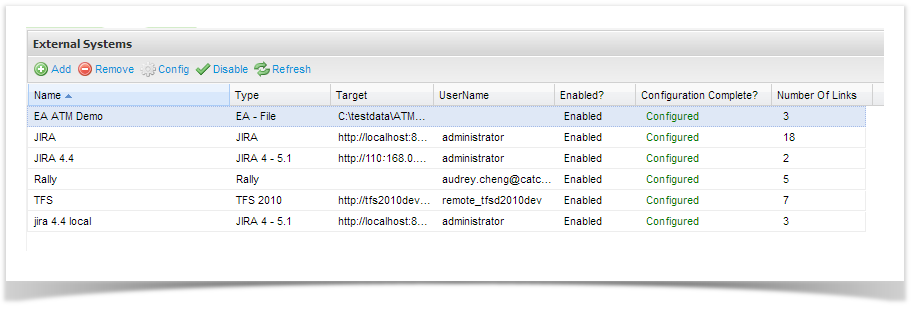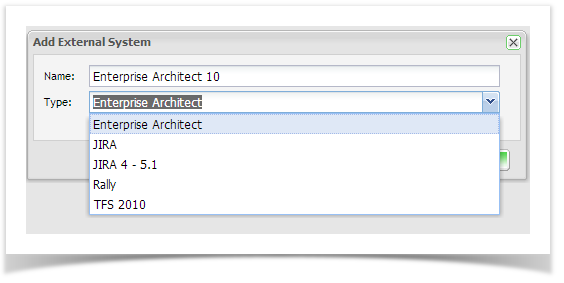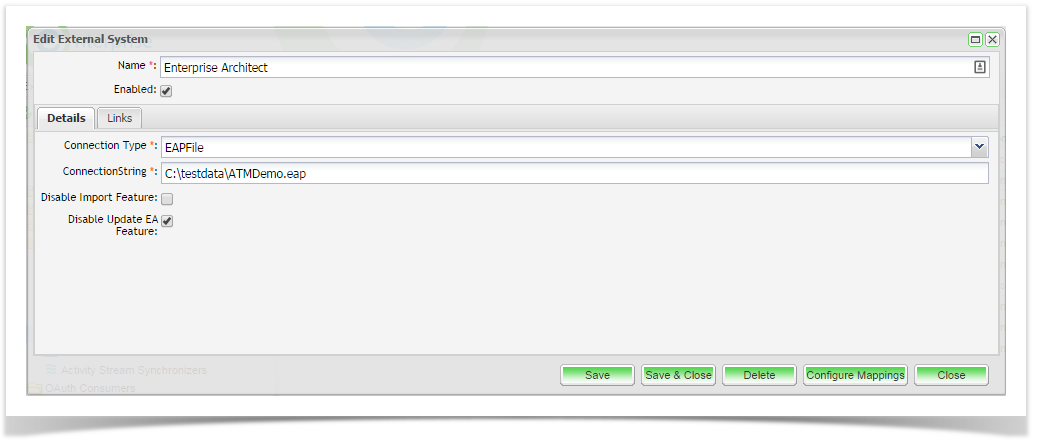Connecting to Enterprise Architect
Enterprise Tester (ET) supports importing Requirements requirements and Use Cases use cases from Enterprise Architect (EA). This This help topic supports configuring details how to configure a connection for importing requirements and use case import cases from Enterprise ArchitectEA. Before Before you begin, please read the help topic External Systems (Integration) . This topic will provide the fundamental which provides details on the fundamentals of setting up an external system.
Supported EA Databases
Many organizations use a single shared repository, which can connect to other repositories, and is managed at an organizational level.
Actual links between project requirements and test cases are then created in the projects and use these EA connections. As part of the set up for a connection you need to configure the mapping of pick list values. This can be done at the connection level which will save you time as you will not need to configure them for each individual link.
Enterprise Tester currently supports connections to the following EA repositories:
Oracle
SQL Server
EAP files
PostgreSQL
MySQL
In order to import your requirements and/ or use cases for your project from EA to ET, two links are required to be set up before you can begin:
Set up a link from ET to your EA database
Set up a project link(s) for your EA requirements and or/use cases to your ET requirements and/or use cases. Note: if you wish to import both requirements and use cases you will need to set up a project link for each of these.
| Info | ||
|---|---|---|
| ||
For the purpose of this help topic, when referring to databases, we are referring to the EA database unless otherwise stated. |
Supported EA Databases
Enterprise Tester supports connections to the following EA database types:
EAP files
MySQL
Oracle
PostgreSQL
SQL Server
If you have more than one EA database, you will need to set up a new connection for each database you wish to connect toYou can have as many connections as you require within your organization.
Default Accounts
Enterprise Tester directly connects to the EA Repository (database), so the account Enterprise Tester runs Tester runs under must be given appropriate permissions, here is the list of default accounts per operating system /IIS version:
IIS Version / Operation System | Default Account |
IIS5.1 - Windows XP | ASPNET |
IIS 6 - Windows Server 2003 | NetworkService |
IIS 7 - WindowsVista/ Windows Server 2008 | NetworkService |
IIS 7.5 - Windows Server 2008r2 / Windows 7 | NetworkService or the AppPoolIdentity (normally IIS APPPOOL\DefaultAppPool - see here for more details : http://learn.iis.net/page.aspx/624/application-pool-identities/) From V4ET v4.1, Network Service will always be the default account in IIS 7.5. |
Database Connections
Database repository connections (Oracle, SQLServer, MySQL, & PostgreSQL) will generally "just work" when using an embedded username/password in the connection string.
If you are using a connection string that uses integrated authentication, then the user the Enterprise Tester application runs under i.e. NetworkService, must be given permission to read/write data to the target database.
More information on each database type can be found below.
SQL Server
For SQL Server - see this article:
...
For Oracle, you can use a "trusted connection" by specifying the OSAuthent=1 parameter in the connection string, see here for examples of connection strings:
http://connectionstringexampleswww.connectionstrings.com/staticpages/index.php?page=20080710090445267oracle/
Adding Add access for an external identified user to Oracle is out of scope for this documentation, but a basic guide can be found here:
...
See the "MySQL Connector/Net" section for details.
Secured Repositories
Enterprise Tester accessed the database tables containing the Element information direction using the ET uses the "Catch API" plug-in to directly access the EA database tables containing the Element information. This by-passes the secured repository security model and therefore no username/password is required. If one is these details are supplied, it they will be ignored.
Creating Enterprise Architect Connections
To create an EA connection navigate to the 'Admin' tab on the ET navigator. Expand Extension Extensions and double click on External Systems.
From the ‘External Systems’ External Systems screen, you can set up your Enterprise Architect EA connection. If All connections that have already been previously configured for to other EA repositories or other external systems , they will be listed here.
Click 'Add' from the tool bar toolbar to bring up the ‘Add Add External System’ System dialog box.
Enter a name for your external system connection and select your external system type. Click Click on 'Save' OK.
On the edit External System screen enter in the following details:
Enabled - select to enable this connection. You may wish to enable this connection once the configuration is complete.
Connection Type - select the EA repository database type from the drop down list of supported databases.
Connection String - the connection string details are dependent depend on the connection type (see details below). More information can be found below under the specific database connection types.
Disable Import Feature - selecting this option will remove the ability for users to import requirements and use cases from EA. You may wish to disable this option after your initial import of requirements and uses cases. This feature maybe useful if you wish to restrict the use of this feature by only enabling it just before initiating an import.
Disable Update EA Feature - selecting this option will disable the ability to update EA requirements and use cases with the data in Enterprise Tester. Note that when this feature is enabled users can update EA with the current values in ET. This process does not take into consideration which system was last updated, the values in ET will override the values in EA regardless of which system was updated last.
Configuring the Connection String
Oracle Connections
This is an example of the connection string required to access the Oracle database:
...
You can copy this from the EA connect connection dialog of an existing connection that has been set up in Enterprise Architect. From the Open Project pop up screen in EA right click on one of the projects that resides on your database and select Edit Connection String. The Connection String pop up screen will appear allowing you to copy the connection string for your database.
SQL Server Connections
This is an example of the connection string required to access the SQL database:
...
You can copy this from the EA connect connection dialog of an existing connection that has been set up in Enterprise Architect. From the Open Project pop up screen in EA right click on one of the projects that resides on your database and select Edit Connection String. The Connection String pop up screen will appear allowing you to copy the connection string for your database.
EAP File Connections
The file path to the required EAP file e.g. C:\Testfiles\Demo.EAP. This pathway must be on the ET sever itself or on a network drive that is accessible by the server Enterprise Tester is installed on.
Once you have completed the configuration details, Enterprise Tester will then test the connection and if successful the connection will automatically be tested upon saving. If a connection to the EA database is made successfully then it will be saved otherwise you will receive an error indicating that the file does not exist.
Enterprise Architect and Enterprise Tester Field Mappings
Once the EA connection is saved the field mapping will need to be set up before you can import or synchronize between EA and Enterprise Tester. You can configure this at the organisational level so that you don't need to complete the mapping for each project. However, Configuring the mappings at the connection level will apply the field mappings across all project links provided these values are already set up for both your EA and ET projects. This is useful if most of your project share the same values for the following fields:
- Priority
- Script Status
- Requirement Status
- Difficulty
- Type
By configuring your field mappings at the connection level you can avoid additional mapping at the project level for each project and link type (requirements and use cases). Note that you will still need to create the project links for each project but you can skip the field mappings step for each project as this will be configured automatically. From the EA Edit External System screen for your EA connection, click on the Configure Mappings button on button in the bottom right corner.
There are two sets of mapping to be configuredThe Map Fields screen will display. You will need to complete mapping the field values for synchronizing in the following directions:
- Enterprise Architect to Enterprise Tester
- Enterprise Tester to Enterprise Architect
To do this:
...
Matching values will automatically be mapped. Field values in ET and EA must be exact matches to be mapped automatically. This feature is case sensitive.
Click on
...
Save when the you have completed the field mappings. The connection is now ready to be used.
| Note |
|---|
See Configuring Enterprise Architect Synchronization for more information on how to import/ export requirements and use cases with Enterprise Architect. |



